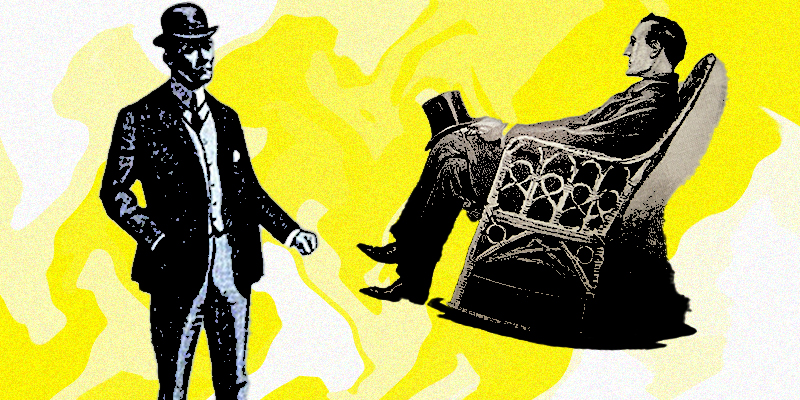CrimeReads has already had a couple interesting articles on Sherlock Holmes and Arsène Lupin written by Olivia Rutigliano, but I thought I would further discuss the topic. As an author with a recent crossover novel involving Holmes and Lupin, The Gentleman Burglar, I have my own perspective. I’ll refer to Holmes throughout as Holmes, although, as is widely known, Leblanc had to change the name in his writings because of Doyle’s displeasure. Hence, in the original French Lupin books, Sherlock Holmes becomes Herlock Sholmès, and in the English translations, Homlock Shears.
It is perhaps a somewhat cliched observation, but in the works of Conan Doyle and Maurice Leblanc, each character seems almost the quintessential representative of his nation. Holmes is the staid rational Englishman, always the polite gentleman with the ladies, while Lupin is the flamboyant trickster Frenchman often in pursuit of both booty and a beautiful woman.
Lupin seems to have had even more wives than Watson, although the exact number seems equally confusing. Lupin’s romantic interest in some lady is often critical to the plot, even when the woman turns out to be villainous, as in 813 or the Countess of Cagliostro. As a general rule, Lupin cannot seem to resist a beautiful woman. Holmes, of course, seems only (and rather briefly) interested in one particular women throughout the entire canon. Other than his admiration for Irene Adler in “A Scandal in Bohemia,” he seems largely indifferent to the fair sex.
Also, although Leblanc admired Conan Doyle and although Lupin is often highly respectful toward his English competitor, Holmes generally serves as the ruthless antagonist to Lupin when he makes an appearance in Leblanc’s works. In fact, Holmes becomes progressively more severe in the narrative, until he becomes really the villain in The Hollow Needle. In that novel (spoiler alert!) Holmes tries relentlessly to hunt down Lupin, and in the end, after being wounded by Lupin, Holmes shoots and kills Lupin’s wife Raymonde, who has thrown herself between the two men. Holmes has also cruelly taken advantage of Lupin’s attachment to his old nurse to entrap him. The book ends on a tragic note brought on by Holmes’s cruelty and his obsession with capturing and one-upping Lupin once and for all.
But setting aside this portrayal of Sholmès, Doyle’s Holmes and Leblanc’s Lupin are fundamentally different characters. Holmes is always and ever the great consulting detective who reasons his way to resolving crimes, and he is on the side of law and order. Lupin begins his career as the clever “gentleman cambrioleur,” the gentleman burglar. He is primarily a thief, and his exploits involve stealing and then avoiding capture by various policemen, foremost among them Inspector Ganimard. Leblanc also makes more use of the cliff-hanger technique, wherein Lupin is in great peril of death or capture, but ingeniously (and sometimes preposterously) manages to escape at the last moment.
Essential to Lupin’s nature is a certain grandiosity coupled with his intellectual brilliance. In The Hollow Needle, he has created a vast criminal empire and squirreled away in his hidden fortress, the Needle at Étretat, various artistic masterpieces which have been replaced, unbeknownst to their owners, by forgeries. In 813 Lupin wants to marry off his daughter to fake nobility and become, behind the scenes, master of all Europe, but his hopes end disastrously with him being responsible, directly or indirectly, for the deaths of three people. Little wonder he throws himself in despair off a cliff into the Mediterranean, but when that doesn’t manage to kill him, he goes off to join the French foreign legion as Don Luis Perenna, one of the many anagrams of his name!
However, in subsequent books such as The Teeth of the Tiger, he becomes more the detective, and his thievery is set aside. Tiger has one of the most ingenious, tangled and complicated of plots, and it ends with Lupin triumphantly marrying yet again. In still later books like The Golden Triangle and The Secret of Sarek, Lupin does not appear until midway in the novels when he shows up just in time and rescues couples beset by villains and facing death. In Sarek, he arrives on an island via his own submarine, The Crystal Stopper.
For my own novel, rather than having Holmes be an antagonist to Lupin, I decided to have the two famed detectives end up working together on a case, one modeled after that portrayed in The Hollow Needle, but with a twist and an additional locale at the conclusion. Holmes finds himself somewhat charmed by Lupin’s youthful zeal and flamboyance. I did have to fudge the dates somewhat in doing this, since my novel takes place in the early 1890s, and the first Lupin story with him in his twenties came out in 1906, while Holmes first appeared in The Study in Scarlet in 1887. I envisioned Holmes about forty and Lupin twenty-five.
I also clarified and expanded on Lupin’s origins as a thief. We find in the first Lupin book, in chapter six, “The Queen’s Necklace,” that he began his career as a thief at the age of six by stealing a valuable diamond necklace. The actual theft seems feasible, but not the idea that a child could plan and then manage to sell off the diamonds to a fence. I liked the idea of Lupin being a sort of child prodigy of crime, so I created Lupin’s grandfather, an ex-burglar incapacitated by an injury, who assisted the boy with the theft and the sale. I also added to Lupin’s backstory and gave him a brief career as an actor.
And of course, I kept his remarkable capacity for disguise! Holmes is also a master of disguises, but he tends to use them only briefly to investigate. With Lupin, one of the hallmarks of the books is his frequent lengthy appearances under other identities. Sometimes the give-away is those anagram names like Don Luis Perenna or Prince Paul Sernine, but other times the reader is fooled and doesn’t catch on until a grand reveal. The first of the stories, “The Arrest of Arsène Lupin,” sets the pattern, and the reader doesn’t discover until the end that the first-person narrator, one Bernard d’Andrézy, is actually Lupin. Also, I was certainly caught by surprise when the fifty-five year-old chief of Paris detectives in 813 turned out to be Lupin. Leblanc did have to cheat somewhat in this case: Lupin had multiple identities, and you have to wonder how he could scurry back and forth and sustain each role!
Another point of similarity is that each character has his own iconic image, but it is an image that really doesn’t appear much in the books. With Holmes, it is him smoking a pipe in his double-brimmed deerstalker cap. Sidney Paget did illustrate Holmes wearing the cap a few times, but Holmes is more often bare-headed, and he is also seen with a top hat or bowler. Still, the deerstalker cap has become his trademark. With Lupin, it is his portrait with a black top hat, a monocle, formal wear with white gloves and a stick. The cover art of the first book, Arsène Lupin, Gentleman-Cambrioleur in 1907 shows a headshot of Lupin dressed that way, and the image has stuck, even though there is no extended description of him appearing that way in the stories. One is reminded of how Bela Lugosi in white tie and tails, plus black cape, forever became the personfication of Dracula.
Shortly after their first published appearances, both Lupin and Holmes showed up in stage plays, and in the twentieth-century, both quickly and repeatedly made it to film. Recently the characters have been resurrected in popular series: Holmes by Benedict Cumberbatch and Lupin by Omar Sy. Lupin has even spawned a Manga series with his grandson Lupin 3! The two detectives continue to captivate the British and the French, and they have gone on to have an international appeal. Over a century after their creation, Sherlock Holmes and Arsene Lupin still fascinate readers and viewers.
***


















